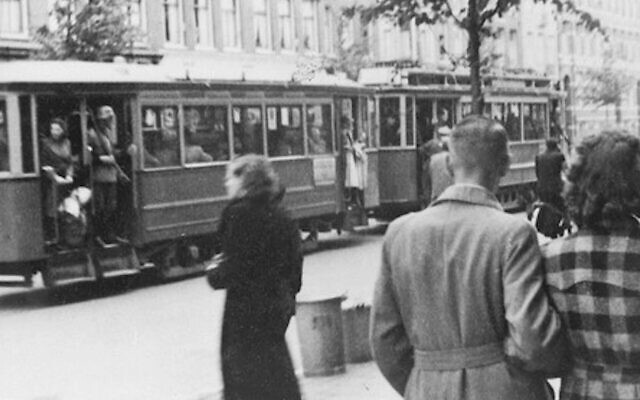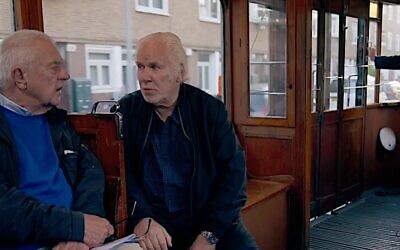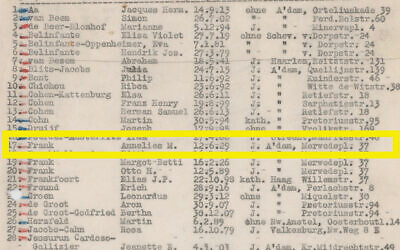Dutch tram company that carried Anne Frank to her doom sought compensation after the war
Most of the Jews forced onto the trams did not survive: More than 100,000 Dutch Jews — three-quarters of the country’s Jewish population — were murdered in the Holocaust.

Abraham Schuster was 5 years old in the spring of 1942 when he and his family were rounded up from their Amsterdam home and shoved onto streetcars under Nazi guard.
He remembers it clearly: “We were taken in a big razzia [raid]. We were taken, like many others from the city, and thrown into the trams.”
Trams operated by GVB, still the city’s public transport company, took the Schusters — and tens of thousands of Amsterdam Jews — to trains, which took them to a transit camp in Holland and ultimately to the Bergen-Belsen concentration camp in Germany or to death camps in Nazi-occupied Poland.
Most of the Jews forced onto the trams did not survive: More than 100,000 Dutch Jews — three-quarters of the country’s Jewish population — were murdered in the Holocaust.
Now, the long-forgotten role of Amsterdam’s trams in the deportation of Jews is getting new attention, thanks to the discovery of documents proving that the GVB was working directly for the Nazis — and that the company tried to recover its costs even after the war’s end.
The documents included a list of deportees featuring the names of Anne Frank and her family, and receipts and unpaid bills from the GVB to the German railway. They are being brought to light thanks to “Lost City,” a new film and book about the tram company’s Holocaust history, produced by the Emmy Award-winning Dutch filmmaker Willy Lindwer and his colleague, the historian Guus Luijters.

For the film, Lindwer and Luijters traveled through the city on an original tram used to transport 48,000 Jews out of the city and interviewed the last survivors.
The revelations have sparked renewed efforts to convince the Amsterdam tram company to pay some form of reparations, as the Dutch national railway NS did in 2019 when it pledged tens of millions of euros to hundreds of local Holocaust survivors, their widows or widowers, and their children.
The revelations “fill us with horror,” the GVB management said in a statement this week.
“We welcome all the facts being put on the table,” the company said, noting that in 2020 the Amsterdam-based Institute for War, Holocaust and Genocide Studies launched a comprehensive study of the role played by all city agencies — including its transit system — in collaborating with the Nazis. “Together with the municipality, we will enter into discussions with the representation of the Jewish community in Amsterdam.”
The revelations come amid a flurry of attention to the Netherlands’ Holocaust history, including the opening of the country’s national Holocaust museum next week. Next year, the country will open its archives about Dutch collaboration with the Nazis to the public for the first time.
A prominent Dutch Holocaust historian, Johannes ten Cate, first located the GVB documents decades ago but had not made them a focus of his work, Lindwer told JTA. When Lindwer’s team approached ten Cate, he directed them to the trove of material.
“I said, ‘This is amazing. This is exactly what we are looking for,’” Lindwer recalled in an interview. “I mean, this proves that the Amsterdam train was instrumental in taking out the Jews of Amsterdam.”
Previously, the tram company had sidestepped criticism that it had been complicit with the Nazis.
“They always denied” their role, Lindwer said “They always said, ‘Well,

there has to be research. We don’t know yet.’ Now it is totally proven.”
Lindwer, whose parents survived the war in hiding, told JTA that he hopes the company would consider putting “money into a fund for Holocaust education and antisemitism education in Holland.”
One of the documents showed that a collection agency tried for two years to recover 80 Dutch guilders (about £389 today) from the German government in 1947, two years after liberation, for the last tram transport — on Aug. 8, 1944. Among the unpaid invoices were those for the transports on which Anne Frank and her family, ripped from their secret annex hiding place, were sent to their deaths.
Chanan Hertzberger, chairman of the Central Jewish Board of the Netherlands, told JTA that he had been “trying to get in contact with the company to discuss this issue with them.”
It had not responded to the letter he sent about two weeks ago, he said.
“They are saying, and they said it already before, that they are waiting for a report which will be issued in the beginning of next year,” Hertzberger said in a phone interview. But “in this case it is so evident: The invoices are there.”
The Nazis paid the tram bills with funds confiscated from the Jews of Holland and deposited in a special account used to cover the costs of deportation and clearing out Jewish homes, Hertzberger noted. “So the Jews paid for their own transportation” to the camps, he said.
Abraham Schuster and his parents, Aaron and Eva, were liberated from the Bergen-Belsen concentration camp in Germany in April 1945 — the same camp where Anne Frank and her older sister Margot died less than two months before liberation. Schuster’s father later helped rebuild the Jewish community of Amsterdam, and was named its chief rabbi in 1955.
At age 86, Abraham Schuster remembers well the day of his family’s deportation from Amsterdam, in the spring of 1942.
“It was very frightening. There was a lot of noise, but I must say there was a German military man, a [heavy] man with a red face, a thick, beer face I call it, and he was not so angry. But with him came the Dutch collaborators. And they were terrible.”
“I felt this is evil. I mustn’t go with them. So I protested, I cried, I cried, but [it was] no help, of course.”
Amsterdam’s trams still operate under the GVB name. Hertzberger said he is ready to look forward.
“We cannot blame the current board for what happened 80 years ago,” Hertzberger emphasised. “What we can do is to talk to them.”

Thank you for helping to make Jewish News the leading source of news and opinion for the UK Jewish community. Today we're asking for your invaluable help to continue putting our community first in everything we do.
For as little as £5 a month you can help sustain the vital work we do in celebrating and standing up for Jewish life in Britain.
Jewish News holds our community together and keeps us connected. Like a synagogue, it’s where people turn to feel part of something bigger. It also proudly shows the rest of Britain the vibrancy and rich culture of modern Jewish life.
You can make a quick and easy one-off or monthly contribution of £5, £10, £20 or any other sum you’re comfortable with.
100% of your donation will help us continue celebrating our community, in all its dynamic diversity...
Engaging
Being a community platform means so much more than producing a newspaper and website. One of our proudest roles is media partnering with our invaluable charities to amplify the outstanding work they do to help us all.
Celebrating
There’s no shortage of oys in the world but Jewish News takes every opportunity to celebrate the joys too, through projects like Night of Heroes, 40 Under 40 and other compelling countdowns that make the community kvell with pride.
Pioneering
In the first collaboration between media outlets from different faiths, Jewish News worked with British Muslim TV and Church Times to produce a list of young activists leading the way on interfaith understanding.
Campaigning
Royal Mail issued a stamp honouring Holocaust hero Sir Nicholas Winton after a Jewish News campaign attracted more than 100,000 backers. Jewish Newsalso produces special editions of the paper highlighting pressing issues including mental health and Holocaust remembrance.
Easy access
In an age when news is readily accessible, Jewish News provides high-quality content free online and offline, removing any financial barriers to connecting people.
Voice of our community to wider society
The Jewish News team regularly appears on TV, radio and on the pages of the national press to comment on stories about the Jewish community. Easy access to the paper on the streets of London also means Jewish News provides an invaluable window into the community for the country at large.
We hope you agree all this is worth preserving.





















